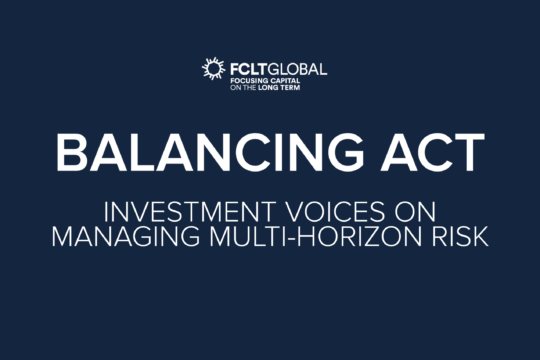The safe assumption is – no one. If anything, we as investors are actively making the future different by committing to net-zero carbon emissions, by maintaining a baseline of flexibility as public-health circumstances change, and by re-emphasizing our community responsibilities relative to the cost-cutting efficiencies of globalization.
We understand, as a result, that the past does not represent what we can expect from the future.
But does data from the past about asset prices represent what we can expect from the future?
Paradoxically, many of us still act as though data about asset-price movements and relationships from the 1990s to today can represent those that we will experience from today to the 2050s. And, to the extent that we acknowledge this paradox, we spend a great deal of our time in response trying to hone our statistical methods so that past data can become representative.
GIC and MSCI offer a starker alternative in a 2022 study called Building Balanced Portfolios for the Long Term, and members workshopped these practices in an FCLTGlobal salon on 16 March.
Grace Qiu and Ding Li of GIC, together with Peter Shepherd of MSCI, write that “the use of backward-looking statistics may be increasingly ill-suited to the challenges facing long-term investors today, who need a framework to understand and manage the risks and return opportunities they face across all asset classes.”
Statistics summarizing past data don’t provide that framework, in this telling.
Qiu, Li, and Shepherd persuasively argue that models of future macroeconomic scenarios provide better data inputs for long-term investors’ asset allocations. And, in the salon, members grappled with putting these ideas into practice in ways that reinforce FCLTGlobal’s mission to drive long-term value creation for savers and communities.
The theme is reminiscent of insight of Wellington’s Chris Goolgasian in a 2021 webinar on how climate change affects asset allocation:
“One of the sins of the financial markets is it’s really a pattern-recognition industry. If you think about patterns like quality, momentum, value, we’ve got a hundred years of history, and everyone imagines that history will persist over some time… there’s no such thing for climate change. We don’t have the history in terms of what the future is going to be, we don’t have enough years… I think classically Wall Street quants will be trying to sort through data and come up with some relationship, but it’s going to be hugely spurious because there’s not enough climate data… what I recommend is that we use forward-looking projections essentially for the first time in our industry without a back history to prove them. The back history of proof is that the science has been accurate.”
There’s a behavioral dimension to this challenge, though, beyond just the statistics. The availability heuristic is at play here in several ways.
At the surface, long-term investors struggle to adopt longer-term methods of asset allocation because the availability of past data is so blinding. Past data is massive, rich, familiar, and we can precisely estimate nearly any statistic that we can imagine – whether we have any reason to expect that statistic to be accurate in representing the future.
At the second level, it is very easy to assume that, because data inputs about the future are much less precise, they don’t meaningfully exist at all. Call it “unavailability bias” – and note that it emerges here from mistaking precision – how many decimal points we can have in our estimate – for accuracy – whether that estimate is representative of the future at all.
This is one reason we still assume that data about asset-price movements and relationships from thirty years ago can represent what we will experience in the next few decades. It’s not that we believe it to be true. It’s that we perceive it to be the only information available. (Let’s just set aside the issue of whether inaccurate numbers can be called “information” at all.)
Longer-term methods, like those pioneered by GIC and MSCI, are necessary for longer-term asset allocation. Yet behavior change is excruciatingly hard, as the discussion in our recent salon made clear. The circumstances for change will only be sufficient when investors are able to overcome biases – like availability– by insisting on empirical accuracy (representativeness) before precision.



